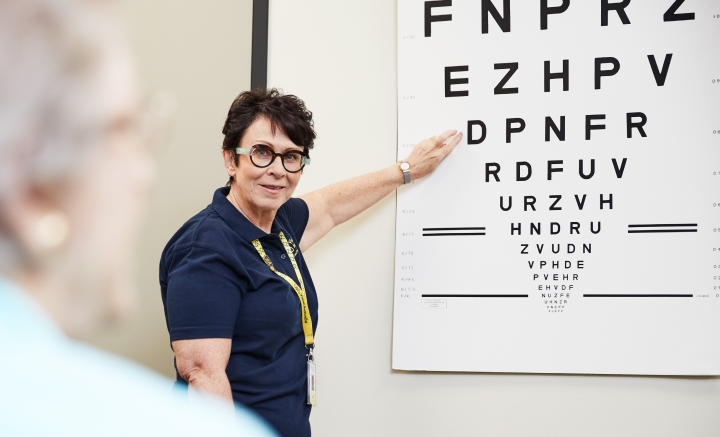
There is a difference between blindness and low vision even though these terms are often used interchangeably.
Vision is a spectrum
At Vision Australia, we use low vision to describe someone with some remaining vision but may need to be twice as close to an object as someone with normal vision in order to see it.
Blindness is when someone has little, or no sight, and needs to rely on their other senses like touch and hearing to understand and get around. It is actually very rare for someone to experience no sight at all.
How do you know if you have low vision?
A person is said to have low vision when they have permanent vision loss that cannot be corrected with glasses and is starting experience symptoms that affect their independent living skills, might be causing falls, or is negatively impacting their emotional wellbeing.
More about how to know if I have low vision?
Common eye conditions
Learn about the types of eye conditions that can cause blindness or low vision.
Age-related macular degeneration
The leading cause of vision loss in Australians over 40.
Read more about Age-related macular degenerationAlbinism
A genetic condition that affects the body’s ability to produce melanin.
Read more about AlbinismDiabetic retinopathy
Damages tiny blood vessels at the back of your eyes.
Read more about Diabetic retinopathyRetinitis pigmentosa
A genetic condition that causes cells in the retina to slowly degenerate.
Read more about Retinitis pigmentosaMaintaining eye health
Taking care of your eyes can seem daunting, and it’s important that you take the time to do it properly. To take the guesswork out of eye health, we’ve summarised some simple tips to get you started on your way to protecting your vision.
Explore eye health tips
Frequently asked questions
Being diagnosed with an eye condition can be life changing, but it doesn't mean you have to stop doing the things you love. Working with our team of experts will empower you with skills and strategies to continue to live life on your terms.
Vision Australia's team of experts can support you to understand your eye condition and maximise your remaining vision. We can also support you to get out and about in your community, connect with others, retain or find a job post-diagnosis and learn how to use technology to conquer everyday tasks.
Vision Australia provides services for people who are blind or have low vision. A person is considered to have low vision when they have permanent vision loss that cannot be corrected with glasses and it affects daily functioning. If you are struggling with your vision and glasses are no longer working, speak with our team of experts on 1300 84 74 66.
Some signs of vision loss often go unnoticed until the symptoms are advanced.
Signs of vision loss typically include the following:
- Blurry vision
- Cloudy vision
- Decreased peripheral (side) vision
- Difficulty seeing clearly at night
- Frequent headaches
- Reduced central vision (what you see straight ahead)
- Seeing halos around lights
- Sensitivity to light
Especially in its earlier stages, certain signs of low vision can easily be attributed to other things. Frequent headaches can be triggered by stress or excessive computer use, light sensitivity can develop from migraines, anxiety, or certain medications, and even blurry vision may be the result of an eye infection, exhaustion, or dehydration.
Low vision is a significant visual impairment, which cannot be corrected by simply wearing glasses or contact lenses. The health consequences of reduced vision extend well beyond the eye.
For example, low vision has been linked to increased risk of falls/injury and negative impacts on mental health.
Book an appointment with our Know Your Vision Clinic and get advice on how to maximise your remaining vision.
Common eye conditions
Learn about the types of eye conditions that can cause blindness or low vision.
Age-related macular degeneration
The leading cause of vision loss in Australians over 40.
Age-related macular degenerationCortical visual impairment (CVI)
Temporary or permanent vision loss due to neurological damage in the brain.
Cortical visual impairment (CVI)Retinitis-pigmentosa
A genetic condition that causes cells in the retina to slowly degenerate.
Retinitis-pigmentosa










